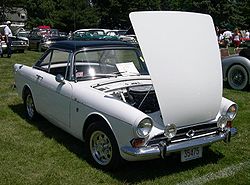Sunbeam Tiger
| Sunbeam | |
|---|---|
|
Sunbeam Tiger
|
|
| tiger | |
| Production period: | 1964-1967 |
| Class : | Sports car |
| Body versions : | Roadster |
| Engines: |
Petrol engines : 4.3 - 5.3 liters (121–183 kW) |
| Length: | 3962 mm |
| Width: | 1537 mm |
| Height: | 1308 mm |
| Wheelbase : | 2184 mm |
| Empty weight : | 1163-1168 kg |
The Sunbeam Tiger was the muscle car version of the "Series" - Sunbeam Alpine .
Rootes Group's sales director for the US West Coast, Ian Garrad, realized that the Sunbeam Alpine image was that of a touring car , not a sports car . He wanted to change this image, using the successful Shelby Cobra - a British sports car ( AC Ace ) with an American V8 engine - as a model. He and Doane Spencer, a California racing driver , examined a number of V8 engines and decided that Ford's new Windsor V8 engine, with a displacement of 4261 cc (260 ci.) And an output of 164 bhp (121 kW ) would fit nicely between the longitudinal members of the Alpine.
Sunbeam hired Carroll Shelby to build a working prototype for a budget of $ 10,000. The prototype was made by Shelby's colleague George Boskoff and the result was found to be good enough to be sent to England as a production sample.
A second Alpine Series II was given to Ken Miles , a former Shelby employee, good racing driver and automaker, and he put in a 4261cc V8 engine and 2-speed automatic in less than a week for only US $ 600. Ken Miles' prototype was kept for some time by Rootes Motors Inc. in Los Angeles and then given to a private buyer.
After extensive design studies, Rootes Group left the development and testing of production start-up to Jensen Motors in Wolverhampton . Jensen Motors then also manufactured the Sunbeam Tiger. 7,085 cars were produced in 3 series (the plant only distinguished 2 series, Mark I and Mark II, but as the official Mark I production used the bodies of two Alpine series - Series IV and V - Sunbeam called Tiger enthusiasts the copies made later usually as "Mark 1A"). Only 536 copies of the Mark II were produced, so that these Tigers with the 289 ci. Engine (4735 cm³) and 200 bhp (147 kW) are very rare today. Amazingly, both prototypes - Shelby's and Miles's - have survived to this day, as well as some historically interesting Tiger models.
Production of the Tiger only lasted from 1964 to 1967 when Chrysler took over the Rootes Group . Chrysler didn't want to sell a Ford-powered car and didn't have a suitable engine of its own. Chrysler V8s all had the manifold on the rear end of the engine, so it was not possible to fit these engines into the Sunbeam's engine bay without major and expensive modifications. So the production of the Tiger was stopped.
Two works cars from the Rootes Group also competed in the Le Mans 24 Hours in 1964 , albeit with little success. The teams Procter / Blumer and Dubois / Ballisat dropped out early in the race due to engine failure.
The Sunbeam Tiger is very popular today as a classic sports car and has amazing potential for historical racing competitions.
In popular culture, people remember the car that Maxwell Smart used to drive to work in the “Control Headquarters” during the first scenes of “Get Smart”.
Note: The name Tiger was used by Sunbeam for a completely different 1925 model. The 1925 Sunbeam Tiger was a racing car with a V12 aircraft engine. Initially this vehicle was called Ladybird , but later the name was changed to Tiger . With its driver Sir Henry Segrave this car exceeded 150 mph (150 mph) for the first time. A second example of this vehicle was made and named Tigress (tigress).
